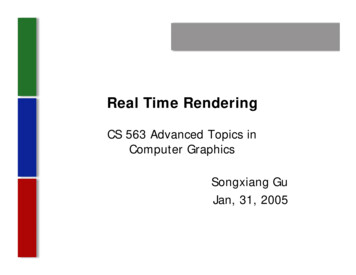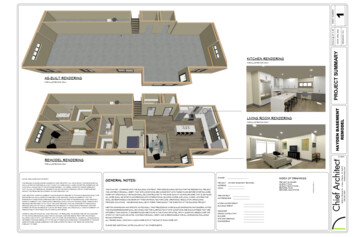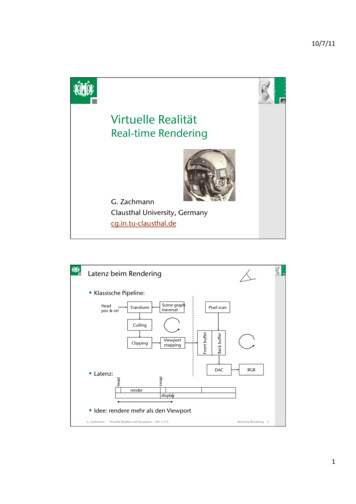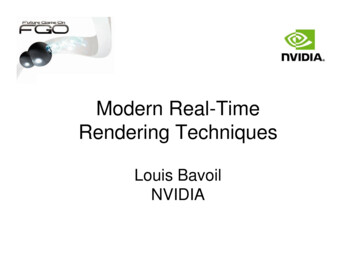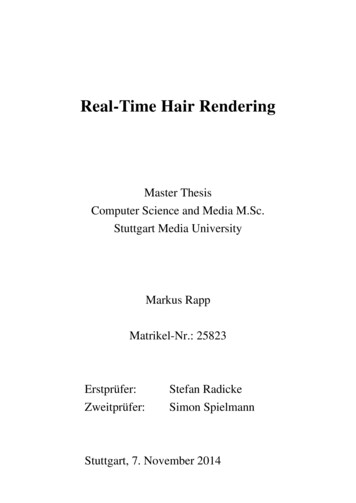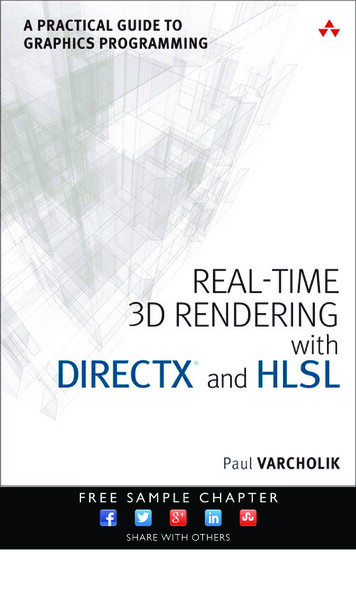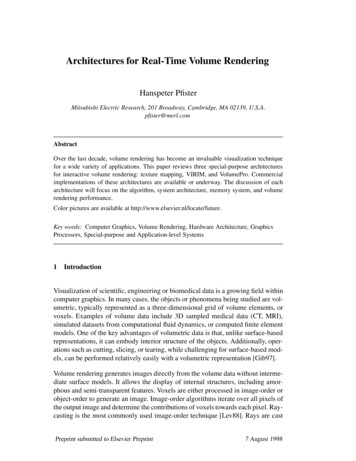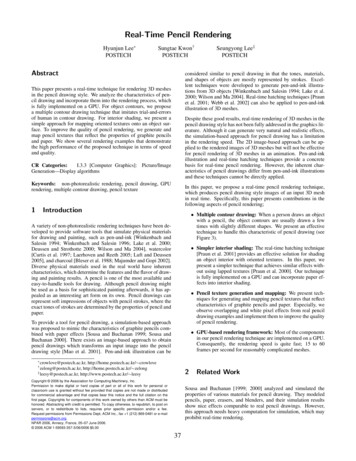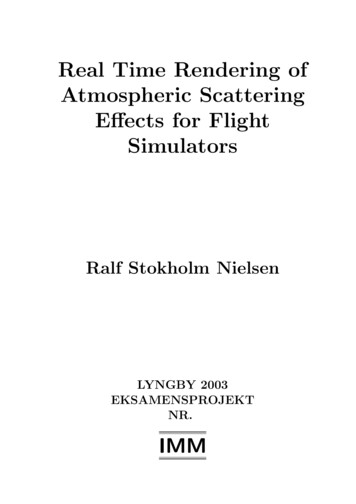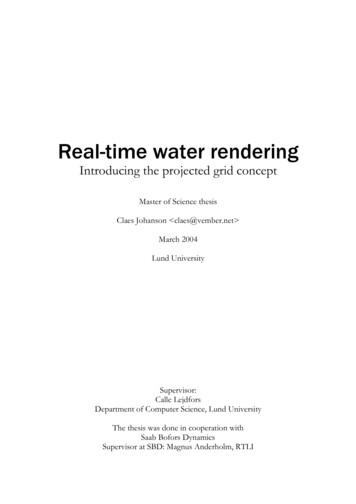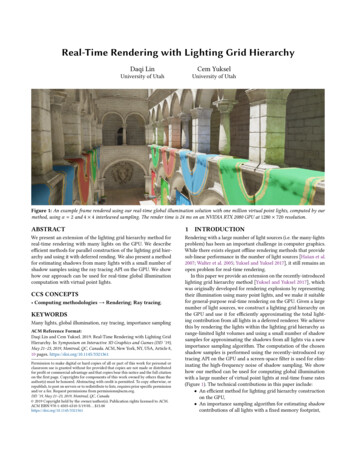
Transcription
Real-Time Rendering with Lighting Grid HierarchyDaqi LinCem YukselUniversity of UtahUniversity of UtahFigure 1: An example frame rendered using our real-time global illumination solution with one million virtual point lights, computed by ourmethod, using α 2 and 4 4 interleaved sampling. The render time is 24 ms on an NVIDIA RTX 2080 GPU at 1280 720 resolution.ABSTRACT1We present an extension of the lighting grid hierarchy method forreal-time rendering with many lights on the GPU. We describeefficient methods for parallel construction of the lighting grid hierarchy and using it with deferred rending. We also present a methodfor estimating shadows from many lights with a small number ofshadow samples using the ray tracing API on the GPU. We showhow our approach can be used for real-time global illuminationcomputation with virtual point lights.Rendering with a large number of light sources (i.e. the many-lightsproblem) has been an important challenge in computer graphics.While there exists elegant offline rendering methods that providesub-linear performance in the number of light sources [Hašan et al.2007; Walter et al. 2005; Yuksel and Yuksel 2017], it still remains anopen problem for real-time rendering.In this paper we provide an extension on the recently-introducedlighting grid hierarchy method [Yuksel and Yuksel 2017], whichwas originally developed for rendering explosions by representingtheir illumination using many point lights, and we make it suitablefor general-purpose real-time rendering on the GPU. Given a largenumber of light sources, we construct a lighting grid hierarchy onthe GPU and use it for efficiently approximating the total lighting contribution from all lights in a deferred renderer. We achievethis by rendering the lights within the lighting grid hierarchy asrange-limited light volumes and using a small number of shadowsamples for approximating the shadows from all lights via a newimportance sampling algorithm. The computation of the chosenshadow samples is performed using the recently-introduced raytracing API on the GPU and a screen-space filter is used for eliminating the high-frequency noise of shadow sampling. We showhow our method can be used for computing global illuminationwith a large number of virtual point lights at real-time frame rates(Figure 1). The technical contributions in this paper include: An efficient method for lighting grid hierarchy constructionon the GPU, An importance sampling algorithm for estimating shadowcontributions of all lights with a fixed memory footprint,CCS CONCEPTS Computing methodologies Rendering; Ray tracing.KEYWORDSMany lights, global illumination, ray tracing, importance samplingACM Reference Format:Daqi Lin and Cem Yuksel. 2019. Real-Time Rendering with Lighting GridHierarchy. In Symposium on Interactive 3D Graphics and Games (I3D ’19),May 21–23, 2019, Montreal, QC, Canada. ACM, New York, NY, USA, Article 8,10 pages. https://doi.org/10.1145/3321361Permission to make digital or hard copies of all or part of this work for personal orclassroom use is granted without fee provided that copies are not made or distributedfor profit or commercial advantage and that copies bear this notice and the full citationon the first page. Copyrights for components of this work owned by others than theauthor(s) must be honored. Abstracting with credit is permitted. To copy otherwise, orrepublish, to post on servers or to redistribute to lists, requires prior specific permissionand/or a fee. Request permissions from permissions@acm.org.I3D ’19, May 21–23, 2019, Montreal, QC, Canada 2019 Copyright held by the owner/author(s). Publication rights licensed to ACM.ACM ISBN 978-1-4503-6310-5/19/05. . . 15.00https://doi.org/10.1145/3321361INTRODUCTION
I3D ’19, May 21–23, 2019, Montreal, QC, Canada A hybrid ray tracing-rasterization approach for renderinghigh-quality diffuse-dominant global illumination in complex scenes using many virtual lights, including dynamiclighting and dynamic geometry at real-time frame rates.2BACKGROUNDIn this section we briefly overview the related work in computergraphics regarding rendering with many-lights and real-time globalillumination computation. We also provide a summary of the lighting grid hierarchy method [Yuksel and Yuksel 2017].2.1Prior WorkThe many-lights problem received considerable attention in computer graphics [Dachsbacher et al. 2014], starting with orderinglights based on their contributions [Ward 1994], stochastic sampling [Shirley et al. 1996], light clustering using octrees [Paquetteet al. 1998], and precomputed visibility culling [Fernandez et al.2002]. The lightcuts method [Walter et al. 2005] provides a highlyefficient scalable solution to the many lights problem by forming abinary light tree from the light sources. Its extensions address highdimensional integrations [Walter et al. 2006], progressive GPU implementation [Davidovič et al. 2012], bidirectional sampling [Walteret al. 2012], and out-of-core GPU implementation for large scenes[Wang et al. 2013]. An alternative solution to the many-lights problem forms a lighting matrix and approximates its solution [Hašanet al. 2007]. The extensions of this approach include a method forhandling glossy surfaces [Davidovic et al. 2010], reducing flickeringby processing animated sequences [2008], and using cuts [Ou andPellacini 2011] or a reduced matrix [Huo et al. 2015] for accelerating the computation. Recently, the lighting grid hierarchy method[Yuksel and Yuksel 2017] was introduced for rendering explosionsby representing their illumination using many virtual point lights.We extend this method in this paper by providing a GPU-friendlyvariant that is suitable for real-time rendering with many lights, sowe discuss this method in more detail below (Sec. 2.2).Most interactive global illumination methods aim to provide afast estimation of the rendering equation [Kajiya 1986] with geometry approximations using voxels [Crassin et al. 2011; Kaplanyan andDachsbacher 2010], surfels [Christensen 2008; Ritschel et al. 2009a],or spheres [Ren et al. 2006; Sloan et al. 2007]; lighting approximations using photons [Hachisuka et al. 2008; Jensen 1996], virtualpoint lights [Keller 1997; Segovia et al. 2006a], or spherical functions [Green et al. 2007; Ramamoorthi and Hanrahan 2001; Sloanet al. 2002]; screen space techniques [Mara et al. 2016; McGuireand Mara 2014; Moreau et al. 2016; Nichols et al. 2009; Ritschelet al. 2009b]; caching [Jendersie et al. 2016; Vardis et al. 2014]; orreconstruction from sparse samples [Krivanek et al. 2005; McGuireet al. 2017; Silvennoinen and Lehtinen 2017].The method we describe in this paper uses virtual point lights(VPLs) [Keller 1997]. Advantages of using VPLs include easy implementation, stable appearance, and scalability. Due to the lowfrequency nature of diffuse reflection, VPLs are particularly effectivein rendering diffuse indirect reflection, which, in many cases, isthe most important part of global illumination. However, the singularity of point lights cause practical problems. Simply clampingDaqi Lin and Cem Yukselthe inverse square attenuation leads to energy loss. Energy compensation methods that use path tracing [Kollig and Keller 2006],screen space sampling [Novák et al. 2011] or a mixture with photonmapping [Sriwasansak et al. 2018] have been developed to solvethis issue, but they are computationally expensive, particularly forreal-time rendering.An important obstacle for using VPLs in real-time rendering hasbeen the challenge of efficiently handling many light sources. Clustered shading [Olsson et al. 2012] is the first method that presentedreal-time rendering performance with one million point lights;however, it assumes local illumination. Stochastic light culling[Tokuyoshi and Harada 2016] achieves interactive rates by fittingVPLs into the tiled shading framework [Olsson and Assarsson 2011],but introduces banding artifacts that are difficult to filter. Forwardlight cuts [Laurent et al. 2016] can compute the illumination ofmany VPLs using a multi-scale radiance cache, but shadows are notaccounted. More recently, Estevez and Kulla [2018] introduced anefficient method for importance sampling many lights during pathtracing by stochastically traversing a bounding volume hierarchyof light clusters, and this method is recently extended to real-timerendering [Moreau and Clarberg 2019].Computing shadows from many VPLs has been another relatedchallenge. There are solutions for real-time shadow computationfrom hundreds of lights [Olsson et al. 2015, 2014], but scenes usingVPLs for indirect illumination usually require thousands of VPLs ormore. Traditionally, shadows are computed for each of the VPLs, butthis can be too expensive for real-time rendering, unless combinedwith a subsampling technique. Harada et al. [2013] proposed amethod for efficiently casting shadow rays to lights within eachrender tile, but it does not solve the problem for virtual point lightswith potentially global influence radius. Imperfect shadow maps[Ritschel et al. 2008] use a point cloud representation of the scenegeometry to significantly reduce the shadow mapping cost at theexpense of shadow quality.2.2Lighting Grid HierarchyThe lighting grid hierarchy method [Yuksel and Yuksel 2017] provides an effective solution to the many-lights problem, thoughit was originally introduced for rendering explosions with selfillumination by representing the volumetric illumination data asmany virtual point lights. As opposed to alternative solutions tothe many-lights problem, lighting grid hierarchy provides a temporally stable computation. It also allows efficiently precomputingand storing shadows for all lights, which leads to orders of magnitude faster computation with volumetric shadows needed forrendering explosions. In this paper we extend this approach byproviding an efficient parallel construction method, presenting atechnique for efficiently computing the lighting from the hierarchyon the GPU, and introducing an importance sampling algorithmthat avoids shadow precomputation, all of which are crucial forachieving real-time frame rates.The lighting grid hierarchy method represents the entire illumination from all lights at multiple resolutions. Each level of thehierarchy corresponds to a different resolution representation thatapproximates the original lights using fewer light sources. A level is
Real-Time Rendering with Lighting Grid HierarchyI3D ’19, May 21–23, 2019, Montreal, QC, Canada3.1Figure 2: The blending functions B 0 , B 1 , B 2 , and B 3 of lighting gridhierarchy with ℓmax 3, forming a partition of unity for any distanced from the point where lighting is computed.constructed by placing a volumetric grid that encapsulates the original lights. The vertices of the grid approximate the lights aroundthem, such that the contribution of each original light is distributedto the eight neighboring grid vertices using trilinear weights. Agrid light is generated from each grid vertex with non-zero illumination and placed at the illumination center of the original lights itrepresents. The highest resolution grid forms level 1 with the setof light sources S1 . Higher levels ℓ of the hierarchy use grid cellswith twice the size in all dimensions as compared to the level ℓ 1right below them. The highest (coarsest) level ℓmax typically has asingle cell with 8 vertices, forming Sℓmax . Therefore, the number oflevels constructed depends on the resolution of level 1. The originallights are kept at level zero, forming S0 .For providing an efficient solution to the many-lights problem,a lighting grid hierarchy approximates the light coming from different distances using different levels of the hierarchy, providingdifferent resolution representation of the original lighting. Thisis accomplished using blending functions that form a partition ofunity for any distance from the point where lighting is computed(Figure 2). These blending functions determine the influence regions of the lights at each grid level and the incoming illuminationfrom a light is modulated by the corresponding blending functionvalue. Let h ℓ be the grid size of level ℓ. The non-zero regions of theblending functions are determined by distances r ℓ αh ℓ , whereα is a user-defined parameter that determines the accuracy of thelighting approximation. Larger α values lead to blending functionswith larger non-zero regions and result in using more grid lightsfor estimating lighting with higher accuracy.3RENDERING WITH MANY LIGHTSOur rendering algorithm uses the lighting grid hierarchy method[Yuksel and Yuksel 2017] to efficiently evaluate the illuminationfrom a large number of point lights. In our experiments we use thisalgorithm for computing indirect illumination with many virtualpoint lights (VPLs) [Keller 1997], though our lighting computationis independent from how the point lights are generated.We begin with constructing a lighting grid hierarchy from thegiven point lights on the GPU (Sec. 3.1). We use this lighting gridhierarchy within a deferred renderer for efficiently estimating theillumination from all lights (Sec. 3.2). While computing the lighting,we stochastically pick a fixed number of shadow samples to becomputed via ray tracing on the GPU (Sec. 3.3). Finally, we filterthe computed shadows to eliminate the high-frequency samplingnoise and use the result as shadow ratio estimators for computingthe final lighting approximation.Lighting Grid Hierarchy ConstructionThe problem of constructing a lighting grid hierarchy is similar tothe particle-to-grid transfer operations used in hybrid LagrangianEulerian simulation systems [Gao* et al. 2018; Wu et al. 2018].Each level of the hierarchy can be constructed using either scatter[Gao* et al. 2018] or gather [Wu et al. 2018] operations. The scatterapproach loops over each light and adds its illumination to thecorresponding grid vertices. Since the parallel scatter loop involvesatomic operations, it can be highly inefficient for higher (coarser)levels of the hierarchy, as the small number of target grid vertices atthese levels lead to frequent thread contentions in atomic operations.The gather approach, on the other hand, loops over each grid vertexand finds the corresponding lights that contribute to the vertex.This eliminates the need for atomic operations, but requires searchoperations for finding the corresponding lights. This search can beaccelerated by a pre-ordering step [Wu et al. 2018], which can alsobe expensive to compute.To provide an efficient parallel construction algorithm, we splitthe construction process into two steps. In the first step we scatterthe contributions of each input light to the first grid level S1 withthe highest resolution. Since this level involves a relatively smallpercentage of thread contentions, the related atomic operationscan be performed efficiently. In the second step we build the restof the levels using a gather approach. To avoid an expensive preordering step, we build these levels using the grid lights of the firstlevel S1 , which are already ordered by construction. This approach,as opposed to generating all levels directly from the input lightsS0 , leads to some smoothing in the final lighting approximationfrom the lighting grid hierarchy, but provides a highly efficientmechanism for the parallel construction process. Since VPLs areplaced only on surfaces, a significant portion of the grid vertices inthe volume may contain no illumination, especially for the lower(finer) levels of the hierarchy. Therefore, the construction processis completed by a stream compaction pass that is applied for eachlevel to remove the large percentage of unused grid vertices.Since we use a bottom-up construction of the hierarchy by building S1 , we must first determine the size of the grid cells h 1 . Webegin with computing the bounding box of all input lights and setthe grid size of the top level Sℓmax , which only contains a single cell(i.e. 8 grid lights), as the longest edge of this bounding box. Thegrid size for the first level S1 is computed using h 1 h ℓmax /2ℓmax 1 .In our implementation the number of lighting grid hierarchy levelsℓmax is controlled by a user-specified parameter.3.2Lighting ComputationIf the lighting grid is densely populated, such that each grid vertexcontains a light with non-zero intensity, lights around a shadedpoint can be directly gathered from the grid. However, the streamcompaction pass we use for eliminating grid lights with zero intensities prevents trivially finding the lights around a shaded pointsfrom their grid locations. Therefore, we use the lighting grid hierarchy within a deferred renderer for estimating the illumination fromall lights with a light rasterization step. After generating G-buffersfor the scene geometry, we rasterize the lights in the lighting gridhierarchy as (coarse) spheres (approximated using cubes in practice)[Dachsbacher and Stamminger 2006]. Since the blending function
I3D ’19, May 21–23, 2019, Montreal, QC, Canadavalues for the lights in the lighting grid hierarchy are zero beyondthe distance 2r ℓ from the light sources, for each light we draw asphere with 2r ℓ radius. The exception is the 8 lights in the toplevel of the hierarchy, which use blending functions that do notgo to zero with increasing distance, so these lights can be handledseparately by drawing a screen-size quad. This process producesfragments for each pixel that the lights can potentially illuminatewith a non-zero blending function value. Yet, the blending functions can still evaluate to zero for some of these fragments, sinceeach grid light at the higher levels of the hierarchy has a minimumillumination radius r ℓ /2 within which the blending function is zero(see Figure 2). Therefore, we compute the blending function foreach fragment and discard the fragment if it is zero.We perform the lighting computation for each fragment with anon-zero blending function value and accumulate the result without considering shadows. Shadows are computed separately, asexplained below (Sec. 3.3).3.3Shadow SamplingThe lighting grid hierarchy allows estimating the illumination usinga small subset of all lights. Yet, in practice lighting computation ofeach pixel still involves hundreds of lights with non-zero blendingfunction values (especially with relatively large α parameters) andcomputing shadows for each one of these lights can be prohibitivelyexpensive for real-time rendering. Even though the lighting gridhierarchy method allows precomputing shadows (such as shadowmaps) with a reasonable memory usage, this precomputation caneasily become the bottleneck of the entire rendering process. Therefore, we instead stochastically estimate shadows using a fixed number of samples, which are computed via ray tracing on the GPU.We pick these shadow samples during the lighting computation(Sec. 3.2). The shadows computed from these samples are then usedas shadow ratio estimators [Heitz et al. 2018].We must pick the shadow samples randomly, independent of theorder in which the lights are processed, to avoid introducing biasin shadow sampling. Furthermore, this random sampling shouldbe performed independently for each pixel to avoid correlation insampling. This process requires considering the set of all lights thathave non-zero illumination contributions for each pixel. Moreover,since the illumination contributions of each light in the lightinggrid hierarchy can vary drastically, using an importance samplingscheme is crucial for reducing the variance in sampling.We pick a small number of shadow samples for each pixel duringthe lighting computation, while rendering the lights as spheres(Sec. 3.2). These shadow samples are evaluated after the lightingcomputation via tracing shadow rays on the GPU from the pixel positions towards the selected shadow sample locations. The lightinggrid hierarchy we construct contains the variance of the illumination center for each light. We use these variance values for randomlypicking shadow sample positions to produce area shadows, as opposed to using the illumination centers directly. Each one of theshadow samples of a pixel is selected independently. Therefore, it ispossible to have multiple shadow samples of a pixel belonging to thesame light source, though it is improbable in practice, consideringthat each pixel is illuminated by hundreds of lights. Nonetheless,Daqi Lin and Cem Yukseleven if two shadow samples of a pixel use the same light, they arelikely to send shadow rays towards slightly different directions.Let fi be the probability density of picking the light source ifor shadow sampling, such that the probability of picking the lightÍsource is pi fi / nj f j , where n is the total number of lights in thehierarchy. These fi values are determined per pixel based on theillumination contribution of each light for importance sampling,such that fi is non-zero if and only if the light has non-zero illumination contribution (disregarding potential shadowing). Duringlighting computation, we store a running total for the cumulativeÍprobability density fˆi ij f j for each pixel. For each fragmentwith a non-zero fi value, we decide whether to use it as a shadowsample stochastically with probability p̃i fi / fˆi , using the accumulated probability density fˆi while rendering the light source i. Thisstochastic decision is performed separately for each shadow sampleof the pixel. If the light is selected as a shadow sample, it overwritesthe previously selected sample. Note that the first light of a pixelwith p̃1 f 1 / fˆ1 1 is always selected as a shadow sample, thoughsucceeding lights can overwrite the shadow sample. At the end ofthe lighting computation, this process provides k shadow sampleseach with the desired probability pi (see Appendix A for a proof),where k is the number of shadow samples per pixel, controlled as auser-defined parameter.After the lighting computation, during which k shadow samplesare picked, we trace shadow rays on the GPU to determine a binaryshadow value for each sample. The average of the k samples providethe shadow value for the pixel, which can be used as a shadow ratioestimator [Heitz et al. 2018].Stochastic shadow sampling, as explained above, leads to a substantial amount of noise when using a small number of shadowsamples. For eliminating the high-frequency noise in shadow sampling a screen-space bilateral filter can be applied to the computedshadow values before using them as shadow ratio estimators [Heitzet al. 2018]. In our tests we use a wavelet-based filter [Dammertzet al. 2010], which we found to be more effective for filtering theshadow noise of VPLs used for computing diffuse-dominant globalillumination.4IMPLEMENTATION AND RESULTSWe evaluate our method by computing indirect illumination withVPLs [Keller 1997]. The VPLs are generated by tracing light raysup to three diffuse bounces. When the lighting condition changes,we regenerate all VPLs and construct a new lighting grid hierarchy.We use the DirectX ray tracing API for both generating VPLs andcomputing shadow rays. All performance results are generatedusing an NVIDIA RTX 2080 graphics card at 1280 720 resolution.4.1Additional OptimizationsThe process of picking the shadow samples (Sec. 3.3) involvesatomic operations for updating the running total for the cumulative probability density fˆi and overwriting the shadow samples.However, in practice the impact of thread contentions during thelighting computation on the final result can be negligible. An exception is rendering to very small viewports. In our tests we foundthat disabling thread locks produces virtually identical results with10–20% improvement in render times. Therefore, the results in
Real-Time Rendering with Lighting Grid Hierarchy(a) Sample shadows from S1I3D ’19, May 21–23, 2019, Montreal, QC, Canada(b) Sample shadows from S2(c) Difference 8Render time: 32.5 msRender time: 28.5 msFigure 3: Comparison of shadow sampling with and without using the lowest (finest) level of the hierarchy S1 , using 100K VPLs, 4 shadowsamples, and α 1.this paper are generated without thread locks, unless otherwiseindicated.Note that each level of the lighting grid hierarchy encodes theentire illumination of all input lights with a different resolution.Therefore, it is possible to skip using the actual input lights altogether and begin the lighting computation using the first level ofthe hierarchy S1 instead. This can significantly reduce the overdrawcaused by rendering spheres for each light source and acceleratethe lighting computation, but it also introduces some smoothing tothe estimated illumination. Yet, in the case of using VPLs for computing indirect illumination, this additional smoothing can evenbe preferable in practice. Therefore, all results in this paper aregenerated using the lighting grid hierarchy starting from S1 .In addition, due to the large number of grid lights in S1 andtheir relatively small illumination radii, skipping S1 grid lights forshadow sampling can significantly reduce the memory bandwidthand computation time, without obvious impact on the render quality.In our tests we observed an additional 10–15% speedup by skippingS1 for shadow sampling with almost identical render results, as canbe seen in Figure 3. Therefore, the results in this paper do not useS1 for shadow sampling, unless otherwise specified.4.2Lighting Grid Hierarchy ConstructionRendering begins with constructing a lighting grid hierarchy, whichis reconstructed every time the illumination changes and a new setof VPLs are generated. Table 1 compares the computation time ofparallel lighting grid hierarchy construction using scatter operations on the input VPLs and our gather approach using S1 for computing the higher levels of the hierarchy. The computation time ofeach step is listed in the table. The first step computes the collectivebounding box of the lights and the final step merges the grid lightsof all levels into a single buffer to avoid multiple draw calls duringlight rasterization. Notice that our gather method is more than anorder of magnitude faster than the scatter approach. The first two(compute bounds and compute S1 ) and the last (merge levels) operations are identical in both cases. The difference in performancecomes from the thread contentions of the scatter operations forcomputing the higher levels of the hierarchy. In comparison, wecan efficiently construct a lighting grid hierarchy by generatinghigher levels from S1 .A qualitative comparison of lighting grid hierarchy construction methods is provided in Figure 4. Notice that the two methodsTable 1: Breakdown of lighting grid hierarchy construction time.Scatter VPLs Gather from S1Compute bounds1.7 ms1.7 msCompute S12.3 ms2.3 msCompute S22.3 ms1.0 msCompute S34.7 ms1.0 msCompute S423 ms2.0 msCompute S5107 ms1.0 msCompute S6405 ms1.1 msCompute S71,563 ms1.5 msMerge levels0.5 ms0.5 msTotal2,110 ms12.1 msThe timings are generated by averaging 256 frames using 100K VPLswith the scene in Figure 5.for parallel lighting grid hierarchy construction produces similarresults. Yet, an extra level of smoothing and light leakage can beobserved when using our gather operations from S1 (Figure 4b).As one would expect, the lighting grid hierarchy constructiontime depends on the number of VPLs. The total construction timesfor different number of VPLs can be seen in Table 2, showing thatthe construction time using our gather approach grows sublinearlywith the increasing number of VPLs.(a) Scatter VPLs(b) Gather from S1Figure 4: Lighting grid hierarchy construction methods using (a) scatter operations on the input VPLs and (b) our gather operations usingthe first level S1 of the hierarchy, producing similar results.
I3D ’19, May 21–23, 2019, Montreal, QC, Canada1K VPLsRender time: 15.5 ms10K VPLsRender time: 22.4 msDaqi Lin and Cem Yuksel100K VPLsRender time: 28.5 ms1M VPLsRender time: 37.0 msBrute-force 1M VPLsRender time: 15 minutes𝐴𝐴𝐴𝐴𝐴𝐴. ��𝑂𝑂𝑂3002702402101801501209021K grid lightsAverage Overdraw: 1355K grid lightsAverage Overdraw: 19028K grid lightsAverage Overdraw: 222144K grid lightsAverage Overdraw: 254log10 (# 𝐺𝐺𝐺𝐺𝐺𝐺𝐺𝐺 Number of Grid Lights vs.Average OverdrawFigure 5: Heatmaps showing the number of overdraw per pixel during the lighting computation for lighting grid hierarchies generated fromdifferent numbers of VPLs and a log plot of number of grid lights used in lighting computation vs. average overdraw per pixel, showing thelogarithmic growth in average overdraw as compared to the increasing number of lights. The first row shows the corresponding render resultsusing our method with 4 shadow samples per pixel and the brute-force reference generated by computing shadows of each VPL.4.3RenderingFigure 1 shows an example image rendered using our method forcomputing global illumination with VPLs. As expected, our methodcan produce high-quality global illumination, since we can efficiently compute lighting from a large number of VPLs. The performance and the quality of our results depend on the number of VPLsused, the number of shadow samples per pixel, and the parameter αof the lighting grid hierarchy method that determines the numberof light samples used for estimating the illumination.Obviously, using more VPLs leads to a better approximationof global illumination and it also increases the render time. Sincewe do not directly use the VPLs in the lighting computation, theperformance of our results depend on the number of grid lights inthe higher levels of the hierarchy. In our tests we set the numberof levels for the lighting grid hierarchy according to the numberof VPLs and we pick the largest number of levels, such that thenumber of lights in S1 is less than half of the number of VPLs.Thus, in our test the number of lights in the hierarchy is roughlyproportional to the
real-time rendering. An important obstacle for using VPLs in real-time rendering has been the challenge of efficiently handling many light sources. Clus-tered shading [Olsson et al. 2012] is the first method that presented real-time rendering performance with one million point lights; however, it assumes local illumination. Stochastic light culling
